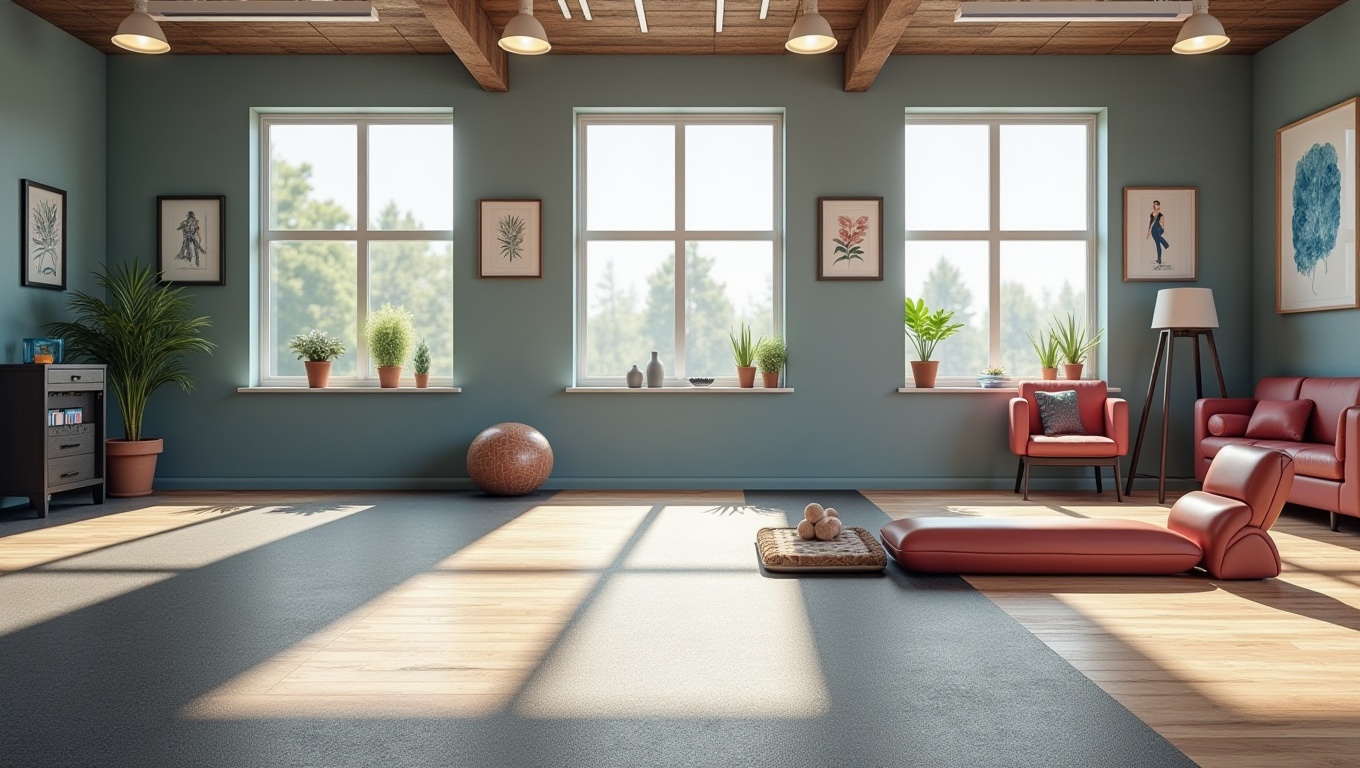Choosing the right flooring for your gym can feel like navigating a minefield. Get it wrong, and you risk damaging your subfloor, injuring yourself, or just wasting money. It has to be just right.
The best material for gym flooring is usually rubber. It’s durable, shock-absorbent, and protects both the floor and the user. Other options exist, but rubber consistently comes out on top for most gym applications due to those benefits.
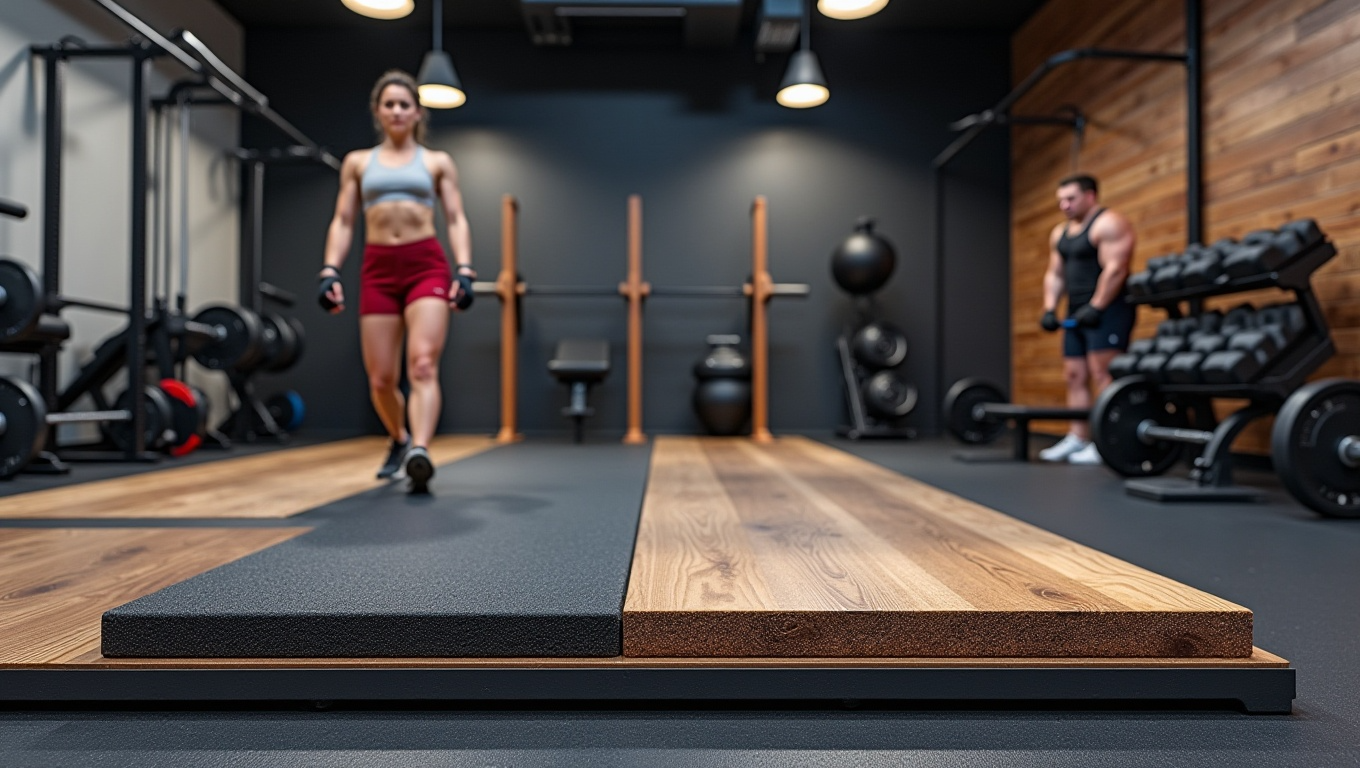 Gym Flooring Materials
Gym Flooring Materials
The world of gym flooring can seem endless. Let’s break down the options, focusing on why rubber is generally the go-to choice, and help you avoid any flooring faux pas.
How Do I Choose the Right Thickness for My Gym Floor?
Choosing the wrong thickness for your gym floor is like wearing the wrong size shoes – it might technically work, but it’s not going to be comfortable, and it could cause problems. Too thin, and you risk damage. Too thick, you are wasting money.
The right thickness depends on usage. For home gyms1, 8mm is often sufficient. But, for professional gyms2 or areas with heavy weights, you’ll want to consider thicker options, potentially exceeding 15mm or even using specialized weightlifting platforms for certain zones.
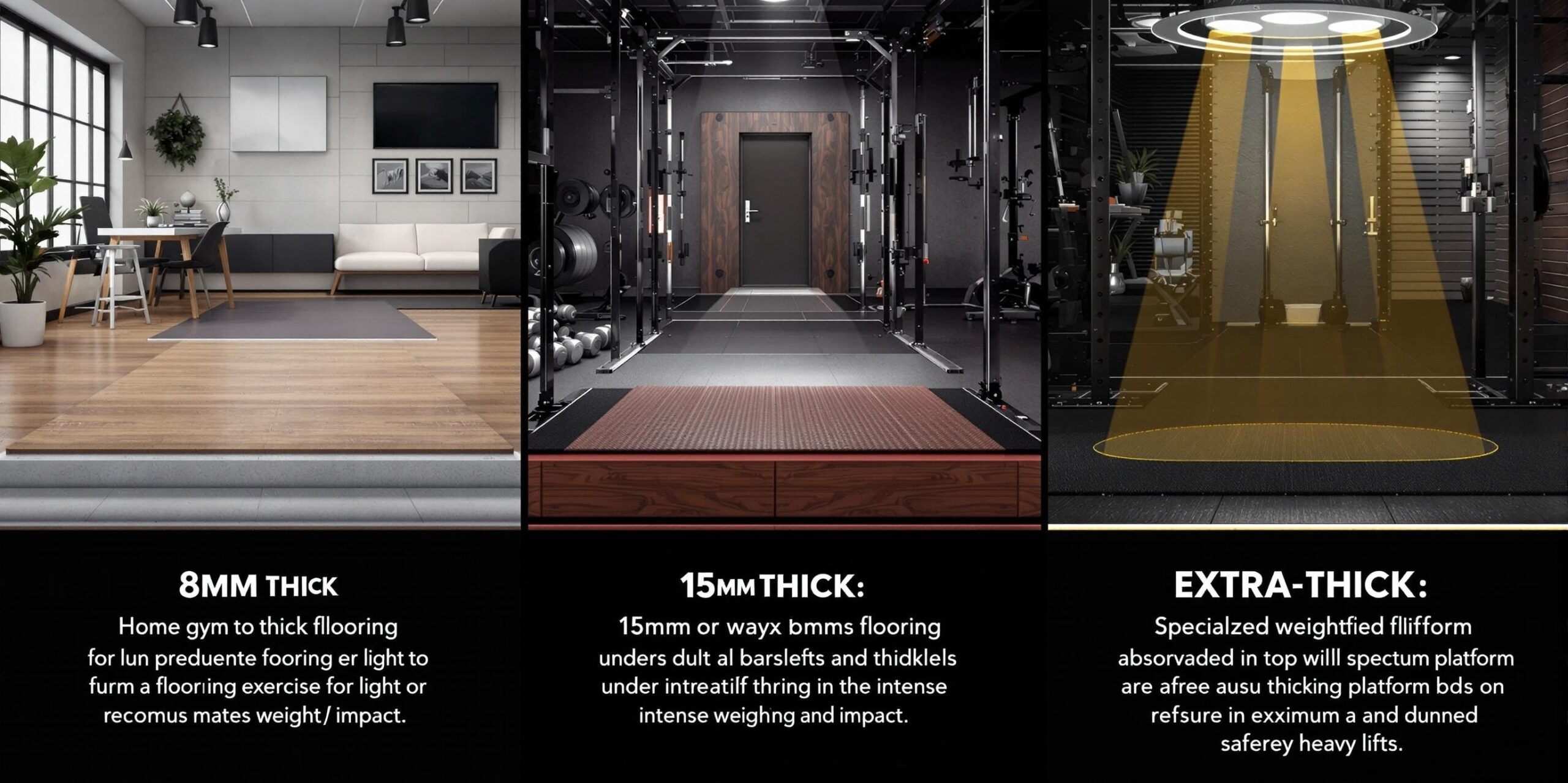 Gym Flooring Thickness")
Gym Flooring Thickness")
Let’s delve a bit deeper to understand the thickness. Think of it like this, the thickness of your gym flooring3 is directly related to the impact it can handle.
Understanding Gym Floor Thickness
| Thickness (mm) | Typical Use | Example Activities |
|---|---|---|
| 3-6 | Light home use, yoga, bodyweight exercises | Stretching, Pilates, light cardio |
| 8 | General home gym use | Moderate weightlifting, treadmill use |
| 10-15 | Commercial gyms, heavy weight areas4 | CrossFit, powerlifting, Olympic lifting |
| >15 | Specialized areas, platform inserts | Dedicated weightlifting platforms |
Choosing the correct thickness is a balancing act. You want enough protection to avoid damaging your subfloor and provide cushioning for your joints, without spending extra money on unnecessary material. Thicker flooring is generally better for heavier weights and high-impact activities. However, thinner flooring can suffice for lighter activities and save on cost. It is best to select flooring that is best for your use
What Are the Pros and Cons of Rubber Flooring for Gyms?
Rubber flooring, it’s everywhere in gyms, but is it all sunshine and rainbows? Like anything, it has its upsides and downsides. Let’s be real about what you’re getting into.
Pros of rubber flooring5 include exceptional durability, shock absorption6, and slip resistance7. Cons include the initial cost, potential odor (especially with new flooring), and the fact that it can be heavy and sometimes challenging to install.
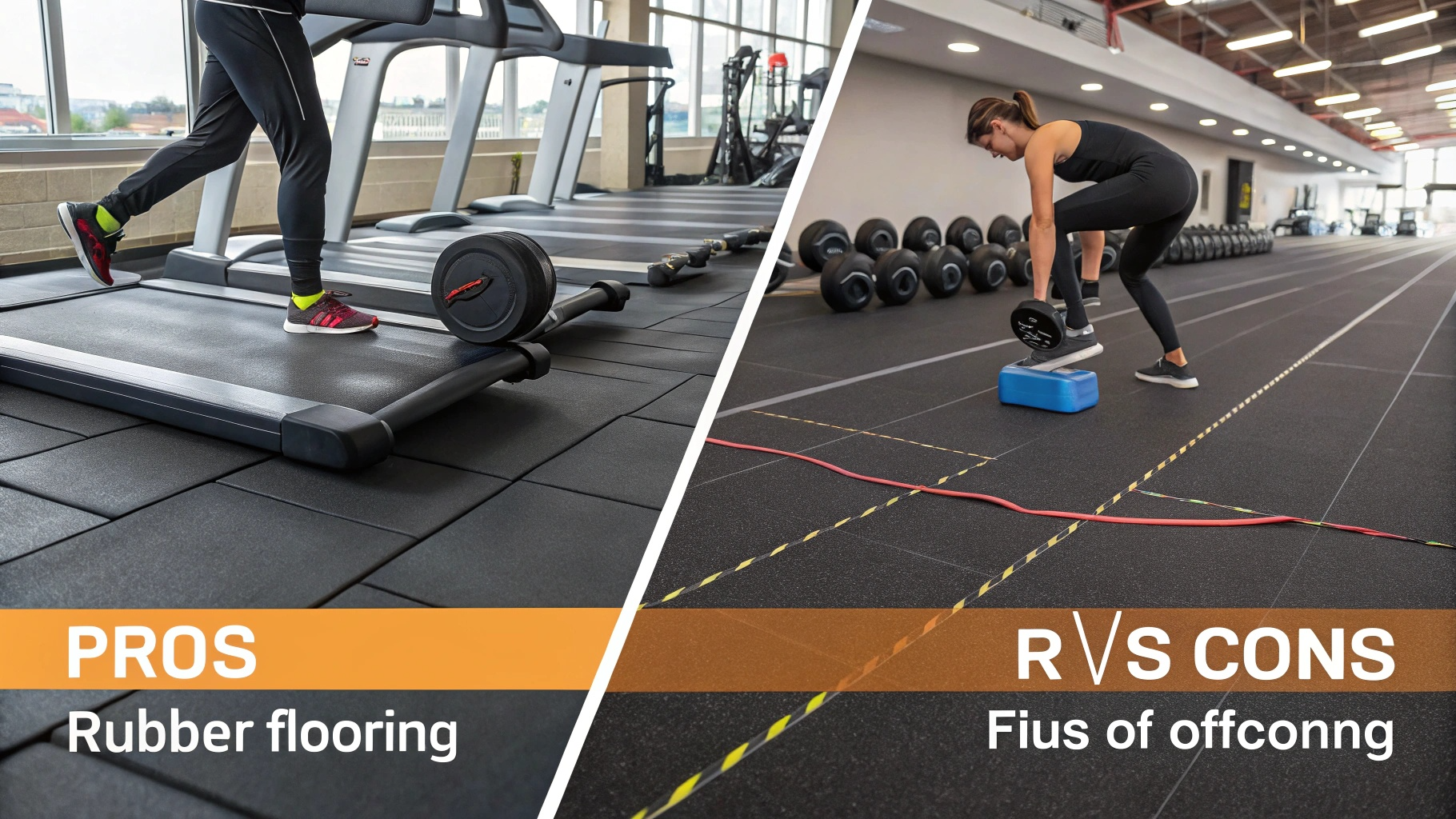 Rubber Flooring Pros and Cons
Rubber Flooring Pros and Cons
Let’s dive into the detail of pros and cons of rubber flooring.
Rubber Flooring: The Good and the Bad
| Feature | Pros | Cons |
|---|---|---|
| Durability | Extremely durable, resistant to wear and tear, can withstand heavy weights and high traffic. | While durable, extreme point loads (like a very heavy, sharp object dropped repeatedly) can cause damage. |
| Shock Absorption | Excellent shock absorption, protecting both the subfloor and the user’s joints. Reduces noise. | Some very cheap rubber flooring may not offer sufficient shock absorption. |
| Slip Resistance | Generally provides good traction, even when wet. | Some finishes or coatings can reduce slip resistance; check the product specifications. |
| Cost | Can be more expensive upfront compared to some other options like foam. | Although more costly at the start, the longevity and durability can make it more cost-effective in the long run. |
| Odor | New rubber flooring can have a strong "rubber" smell, especially in enclosed spaces. This usually dissipates over time. | Look for low-VOC or no-VOC rubber flooring to minimize this issue. |
| Installation | Can be heavy and sometimes challenging to install, especially with interlocking tiles or rolls. May require professional installation for large areas. | Consider professional help for seamless install. |
| Maintenance | Easy to clean and maintain. Usually requires only sweeping and occasional mopping with a mild detergent. | |
| Versatility | Suitable for a wide range of activities, from weightlifting to yoga. Available in various thicknesses, colors, and styles. |
It should be quite obvious that the advantages of rubber flooring far outway the disadvanteges.
Is Recycled Rubber Flooring a Good Option for Gyms?
You’re environmentally conscious, and you’re building a gym. So, recycled rubber flooring sounds perfect, right? It’s a win-win. You get a durable floor, and you’re helping the planet.
Recycled rubber flooring8 is a great option for gyms. It offers the same benefits as virgin rubber (durability, shock absorption9) while being more environmentally friendly10 and often more affordable.
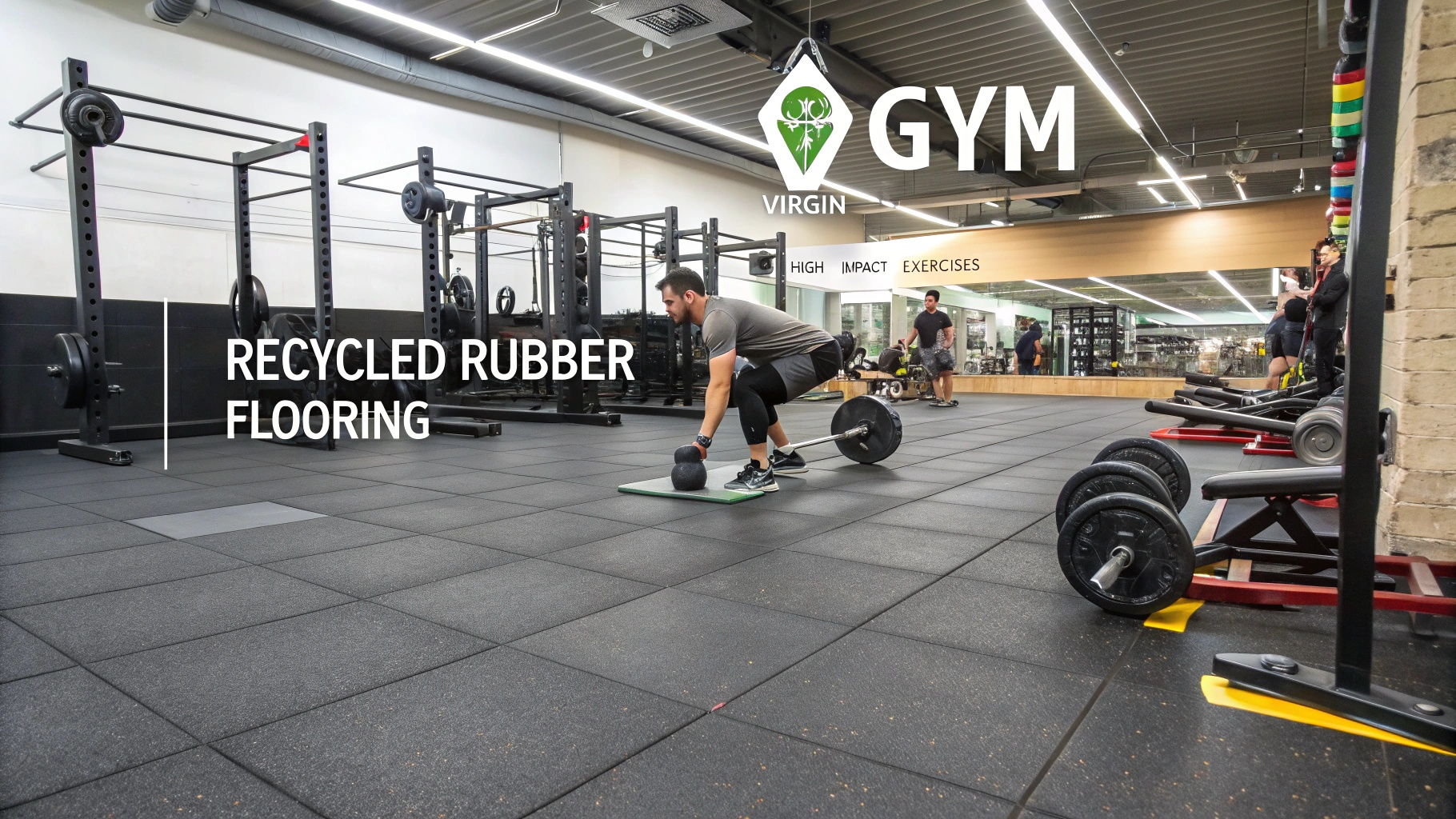 Recycled Rubber Flooring
Recycled Rubber Flooring
Recycled Rubber: Good for the Planet, Good for Your Gym
Recycled rubber flooring, often made from old tires, offers several benefits:
- Sustainability11: Diverts waste from landfills and reduces the demand for new rubber production.
- Durability: Maintains the same durability and performance characteristics as virgin rubber.
- Cost-Effectiveness: Often more affordable than virgin rubber flooring.
- Shock Absorption: Provides excellent cushioning and impact resistance.
- Variety: Comes in many forms, including tiles or mats.
Recycled rubber flooring is a great choice. It has almost all of the benefits of new rubber, while being more sustainable.
How Does Rubber Flooring Compare to Other Gym Flooring Options?
Rubber’s the main contender, but it’s not the only flooring option for a gym. You’ve got foam, carpet, vinyl, and even turf. It’s a flooring showdown!
Rubber flooring12 generally outperforms other options in terms of durability and shock absorption. Foam13 is softer but less durable. Carpet is comfortable but not ideal for heavy weights. Vinyl14 is versatile but may not offer the same level of protection.
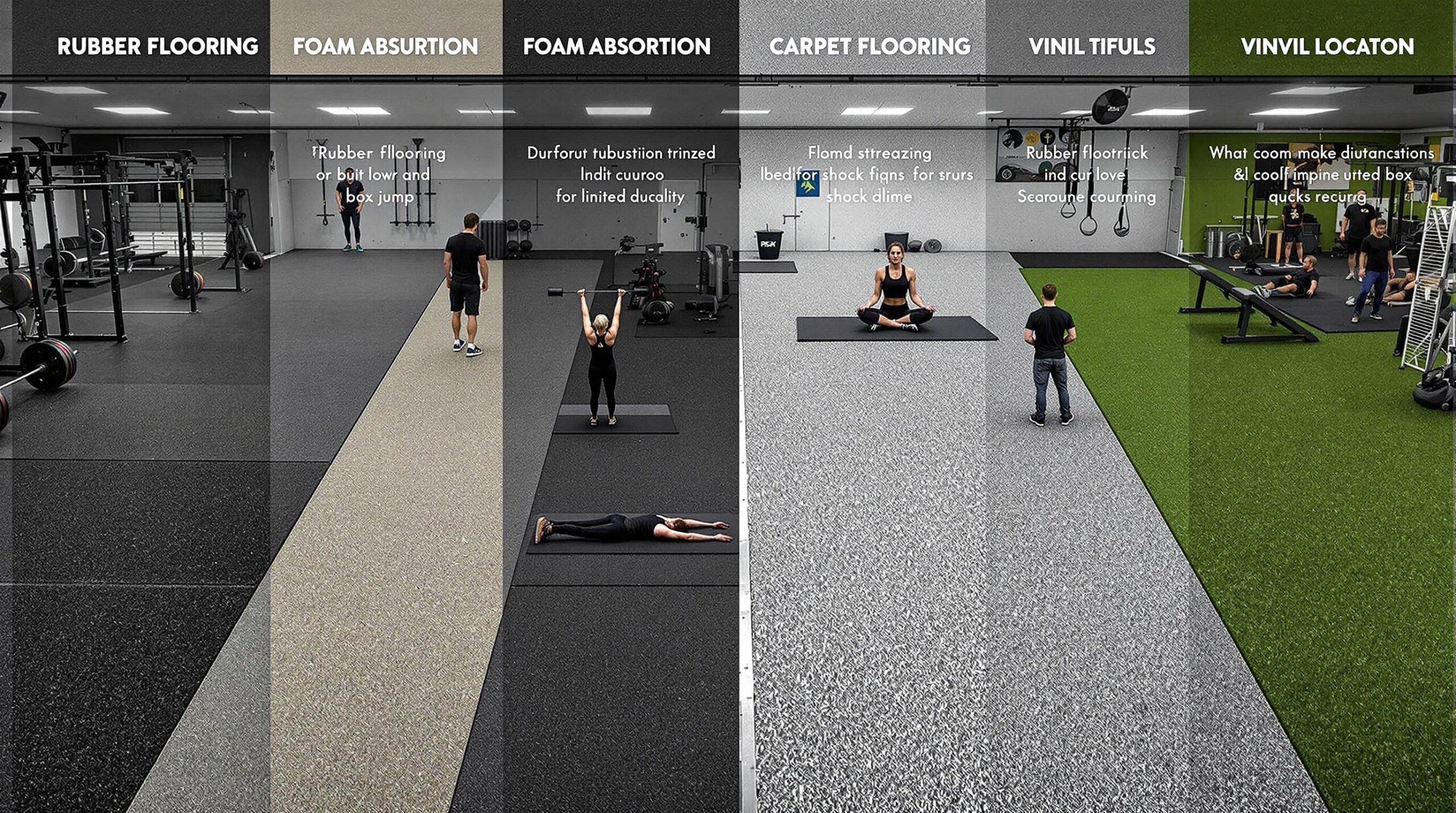 Comparing Gym Flooring Options")
Comparing Gym Flooring Options")
Gym Flooring Options: A Head-to-Head Comparison
| Flooring Type | Durability | Shock Absorption | Cost | Use Cases |
|---|---|---|---|---|
| Rubber | Excellent | Excellent | Moderate | Weightlifting, CrossFit, general gym use |
| Foam | Fair | Good | Low | Yoga, Pilates, bodyweight exercises, children’s play areas |
| Carpet | Fair | Moderate | Low | General fitness areas, stretching, light cardio |
| Vinyl | Good | Fair | Moderate | General fitness areas, dance studios, group fitness classes |
| Turf | Good | Good | High | Functional training, agility drills, sports-specific training |
| Hardwood | Good | poor | high | Basketball courts, dance studios |
While other options have their place, rubber’s combination of durability, shock absorption, and versatility makes it the top choice for most gym applications. Foam can be a good alternative for low-impact activities, but it won’t hold up well to heavy weights.
Why is rubber flooring the best gym flooring option?
Rubber’s reign supreme in the gym flooring world. It is not an accident. It comes down to a combination of factors that other materials just can’t match.
Rubber flooring is the best overall option because it excels in durability, shock absorption, slip resistance, and versatility. It protects the subfloor, reduces noise, and provides a safe and comfortable workout surface.
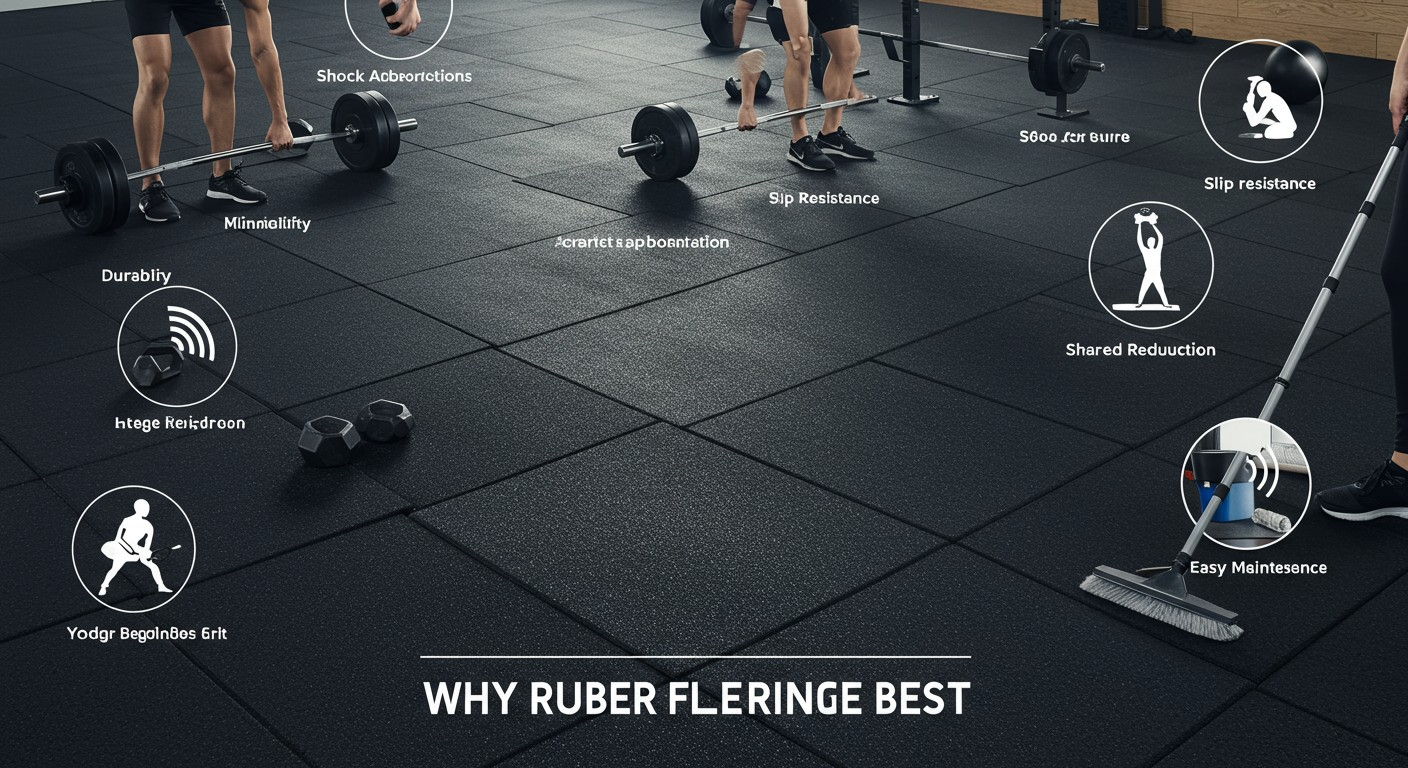 Why Rubber Flooring is the Best
Why Rubber Flooring is the Best
Because of rubber floorings great qualities, it is the most versitile flooring type.
The All-Around Champion: Rubber’s Key Advantages
- Durability: Rubber can withstand the constant pounding of heavy weights and high-impact activities.
- Shock Absorption15: It protects your joints and the subfloor from damage.
- Slip Resistance16: Provides a safe and secure surface, even when wet.
- Noise Reduction17: Rubber dampens sound, making it ideal for shared spaces.
- Versatility: Suitable for a wide range of activities, from weightlifting to yoga.
- Easy maintance: Just needs to be cleaned.
Rubber flooring’s well-rounded performance makes it the clear winner for most gym applications. It’s the workhorse of the gym flooring world, providing a solid foundation for any workout.
What is the best flooring for a gym?
We’ve been through a lot of flooring options, and the question remains: what is the absolute best? It’s like asking what the best exercise is – there’s a "best overall," but it also depends on specifics.
The best flooring for a gym18 is, generally, rubber. Its combination of durability, shock absorption, and versatility makes it suitable for almost any gym environment, from home setups to commercial facilities.
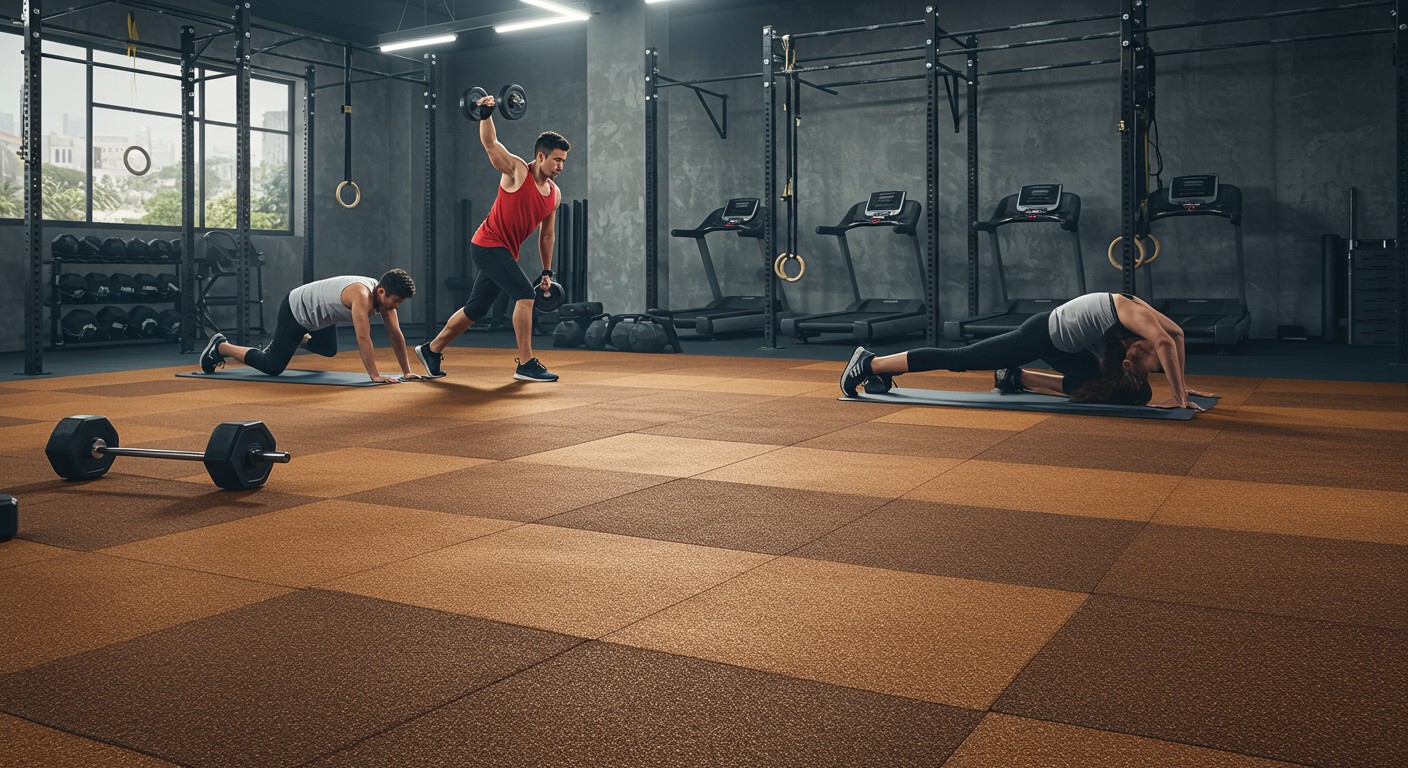 Best Flooring for a Gym
Best Flooring for a Gym
Rubber: The All-Around Winner
While other options like foam or vinyl have their niche uses, rubber’s overall performance makes it the champion. If you have many different kinds of activities in your gym, rubber is best.
What is suitable flooring for gym?
"Suitable" is a broader term than "best." It’s about finding something that works, not necessarily the top-of-the-line option. So, what’s acceptable?
Suitable flooring for a gym includes rubber, foam, vinyl, and even carpet, depending on the specific activities and budget. Rubber is the most versatile and durable, making it suitable for almost any gym.
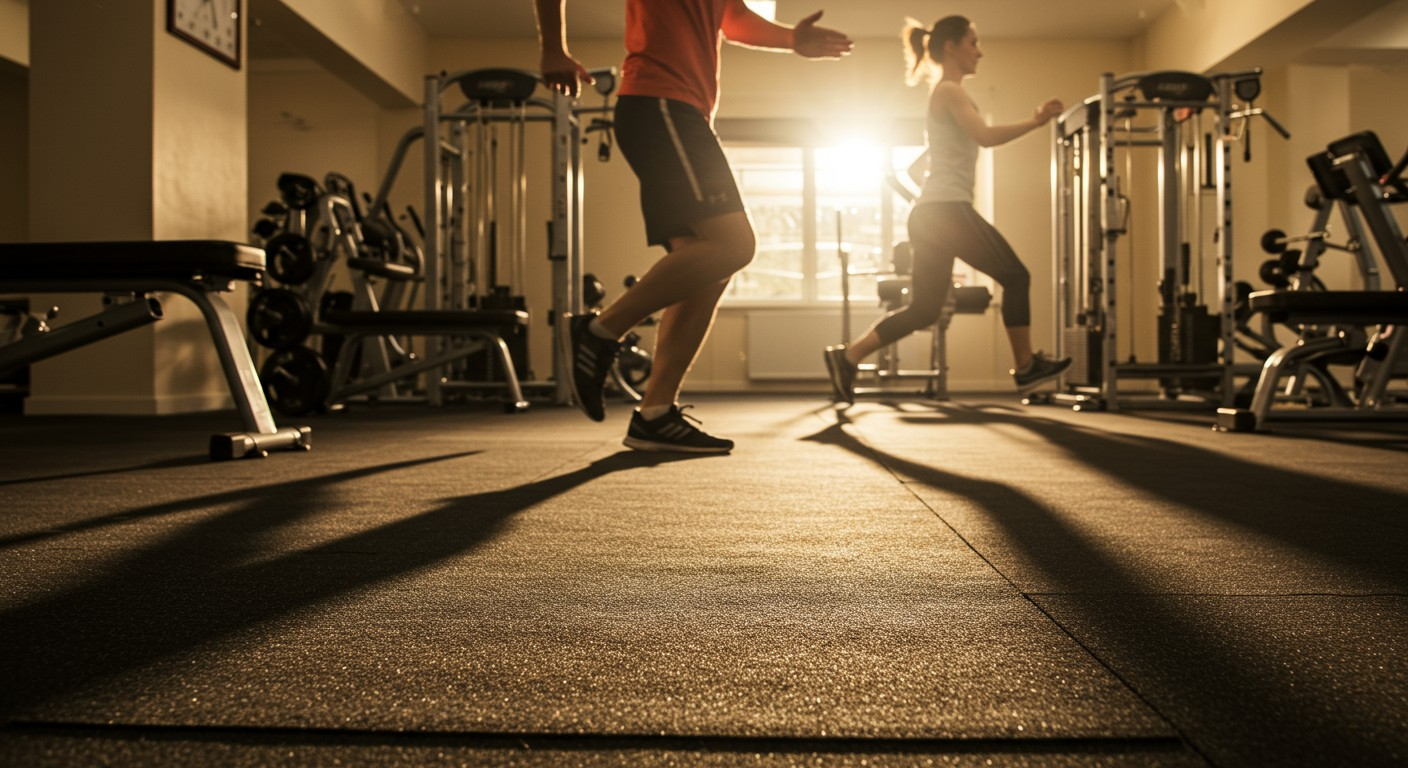 Suitable Flooring for Gym
Suitable Flooring for Gym
Meeting the Minimum Requirements: Suitable Options
- Rubber: The gold standard, suitable for almost everything.
- Foam: Suitable for low-impact activities, bodyweight exercises, and stretching.
- Vinyl: A decent all-around option for general fitness areas.
- Carpet: Okay for stretching and light cardio, but not ideal for heavy weights.
While rubber is the best, these other options can be suitable depending on your needs and budget.
What type of flooring is best for workout room?
Now we’re getting specific: a workout room. This implies a dedicated space, probably at home, maybe in a garage or basement.
The best type of flooring for a workout room is typically rubber. It provides the necessary durability and shock absorption for various exercises, from weightlifting to cardio, protecting both the floor and the user.
 Best Flooring for Workout Room
Best Flooring for Workout Room
Workout Room Essentials: Durability and Protection
A workout room often sees a variety of activities, so you need a floor that can handle it all. Rubber fits the bill perfectly, providing a safe and durable surface for:
- Weightlifting
- Cardio (treadmills, ellipticals, etc.)
- Bodyweight exercises
- Stretching and yoga
Rubber’s versatility makes it the ideal choice for a dedicated workout space.
Is foam or rubber better for a gym floor?
This is a classic head-to-head comparison. Foam is soft and cheap, rubber is tough and more expensive. Which wins?
For a gym floor, rubber is generally better than foam. While foam provides cushioning, it lacks the durability and support needed for most gym activities, especially those involving heavy weights. Rubber offers superior protection and longevity.
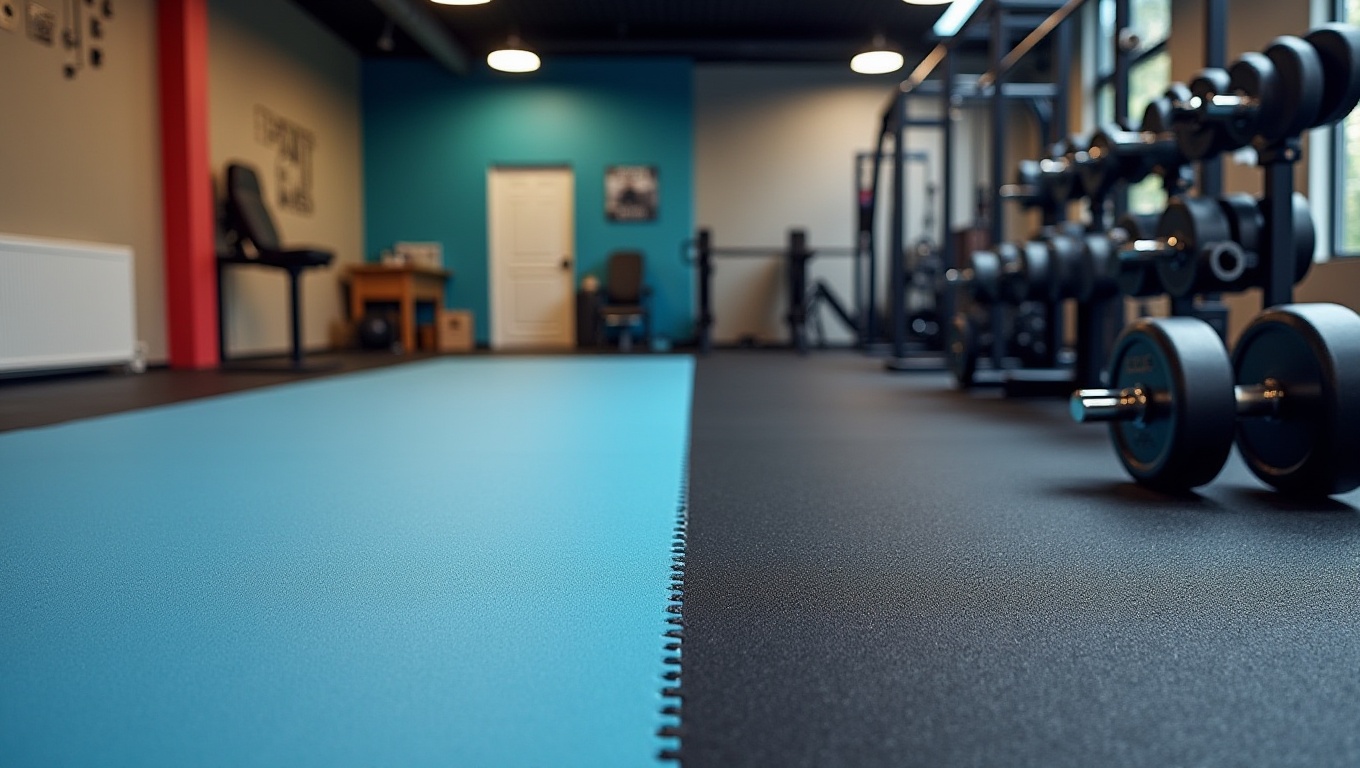 Foam vs Rubber for Gym Floor
Foam vs Rubber for Gym Floor
The Showdown: Foam vs. Rubber
| Feature | Foam | Rubber |
|---|---|---|
| Durability | Low | High |
| Shock Absorption | Moderate | Excellent |
| Cost | Low | Moderate to High |
| Use Cases | Yoga, Pilates, light bodyweight exercises | Weightlifting, CrossFit, general gym use |
Foam has its place, particularly for low-impact activities. But for a true gym floor, where weights might be dropped and heavy equipment is used, rubber is the clear winner. Think of foam as a yoga mat and rubber as the foundation of a weightlifting platform.
For all use cases, rubber is better for a gym floor.
Conclusion
Choosing the right gym flooring is important. While several options exist, rubber consistently emerges as the best overall choice due to its durability, shock absorption, and versatility.
-
Explore various flooring options tailored for home gyms to enhance your workout experience and protect your floors. ↩
-
Discover the best flooring solutions for professional gyms to ensure durability and safety during intense workouts. ↩
-
Explore this link to discover the best gym flooring options tailored for your home workouts, ensuring safety and comfort. ↩
-
Find out which flooring materials are ideal for heavy weight areas to protect your gym and enhance performance. ↩
-
Explore this link to understand the comprehensive benefits and drawbacks of rubber flooring, helping you make an informed decision. ↩
-
Learn about the importance of shock absorption in rubber flooring and how it protects users’ joints and enhances comfort. ↩
-
Discover the factors that influence slip resistance in rubber flooring to ensure safety in your gym or home environment. ↩
-
Discover how recycled rubber flooring can enhance your gym’s sustainability while providing excellent durability and shock absorption. ↩
-
Explore the advantages of rubber flooring in terms of durability and shock absorption, essential for a safe gym environment. ↩
-
Learn about the significance of choosing environmentally friendly flooring options to promote sustainability in your gym. ↩
-
Learn how recycled rubber flooring contributes to sustainability and reduces environmental impact, making it a smart choice for eco-conscious consumers. ↩
-
Explore the advantages of rubber flooring, including durability and shock absorption, to make an informed choice for your gym. ↩
-
Learn about foam flooring’s softness and suitability for low-impact activities, helping you decide if it’s right for your space. ↩
-
Discover the versatility of vinyl flooring and its applications in fitness settings, aiding your flooring decision process. ↩
-
Understanding shock absorption can help you choose the right flooring for joint protection and comfort during workouts. ↩
-
Exploring slip resistance will highlight its importance in preventing injuries during workouts, ensuring a safer gym environment. ↩
-
Learning about noise reduction can enhance your gym experience, especially in shared spaces, by creating a more pleasant atmosphere. ↩
-
Explore this link to discover expert insights and comparisons on gym flooring options, helping you make an informed choice. ↩

